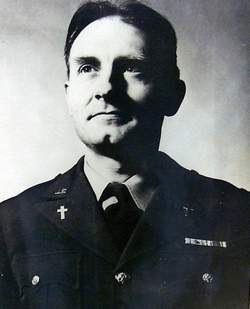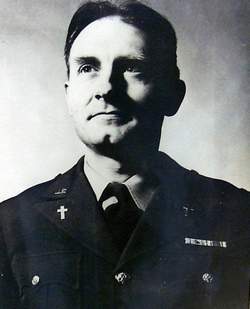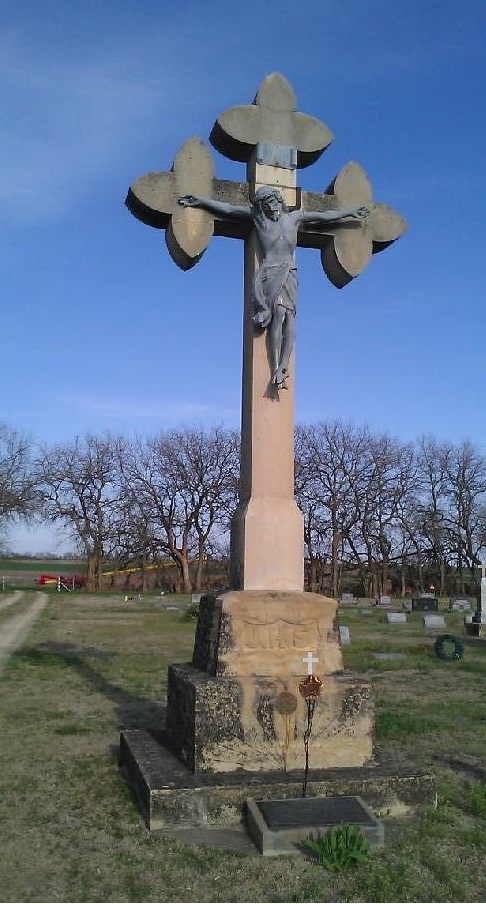Korean War Medal of Honor Recipient. He was the most highly decorated chaplain in the history of the United States military receiving the Bronze Star, the Distinguished Service Cross, The Purple Heart, the Korean Service Medal presented by the Republic of Korea, and finally, the Medal of Honor. Born in rural Pilsen, Kansas, he was ordained a Roman Catholic priest on June 9, 1940 and returned to his home parish of Saint John Nepomucene Church in Marion, Kansas. He joined the United States Army as a chaplain during World War II, serving in India and Burma. After the war he returned to Kansas but volunteered for military service again during the Korean War, and was assigned as Chaplain of the 8th Cavalry Regiment, 1st Cavalry Division. After being taken prisoner in 1950 by the Chinese, he nursed the sick and wounded at a squalid communist prisoner-of-war camp in North Korea, and went to extraordinary lengths to administer and provide for his fellow prisoners despite the deplorable conditions and the cruelty of their North Korea captors. Eventually a blood clot in his leg prevented his daily rounds, and he was moved to a hospital, where he was allowed to die from starvation and pneumonia. He was thrown into a mass grave along with other mistreated American prisoners along the Yalu River. After the war, the Chinese plowed the field and planted it over with rice to hide the site. In the 2000s a campaign was embarked to have his bravery and sacrifice be recognized and honored, the result of which culminated in President Barak Obama posthumously awarded him the Congressional Medal of Honor in April 2013. His citation read "For conspicuous gallantry and intrepidity at the risk of his life above and beyond the call of duty while serving with the 3d Battalion, 8th Cavalry Regiment, 1st Cavalry Division during combat operations against an armed enemy at Unsan, Korea, from November 1-2, 1950. On November 1, as Chinese Communist Forces viciously attacked friendly elements, Chaplain Kapaun calmly walked through withering enemy fire in order to provide comfort and medical aid to his comrades and rescue friendly wounded from no-man's land. Though the Americans successfully repelled the assault, they found themselves surrounded by the enemy. Facing annihilation, the able-bodied men were ordered to evacuate. However, Chaplain Kapaun, fully aware of his certain capture, elected to stay behind with the wounded. After the enemy succeeded in breaking through the defense in the early morning hours of November 2, Chaplain Kapaun continually made rounds, as hand-to-hand combat ensued. As Chinese Communist Forces approached the American position, Chaplain Kapaun noticed an injured Chinese officer amongst the wounded and convinced him to negotiate the safe surrender of the American Forces. Shortly after his capture, Chaplain Kapaun, with complete disregard for his personal safety and unwavering resolve, bravely pushed aside an enemy soldier preparing to execute Sergeant First Class Herbert A. Miller. Not only did Chaplain Kapaun's gallantry save the life of Sergeant Miller, but also his unparalleled courage and leadership inspired all those present, including those who might have otherwise fled in panic, to remain and fight the enemy until captured. Chaplain Kapaun's extraordinary heroism and selflessness, above and beyond the call of duty, are in keeping with the highest traditions of military service and reflect great credit upon himself, the 3d Battalion, 8th Cavalry Regiment, the 1st Cavalry Division, and the United States Army". A cenotaph was erected for him in the Saint John Nepomucene Church Cemetery in his hometown of Pilsen, Kansas, and his name is inscribed on the Courts of the Missing Memorials Walls in the National Memorial Cemetery of the Pacific in Honolulu, Hawaii. In 2021, his remains were positively identified as being buried in the Unknown Soldiers area of National Memorial Cemetery of the Pacific. His remains were discovered buried at the POW location in North Korea, and were positively identified as his in May 2021. On September 24 of that year, Fr. Kapaun's remains were flown from Honolulu, Hawaii to Wichita, Kansas. From there, the remains were taken to Fr. Kapaun's home parish, Saint John Nepomucene, in Pilsen, Kansas for two days, then delivered back to Wichita. A vespers service for the priests of the Wichita diocese and a public vigil followed, culminating in The Mass of Christian Burial on September 29. Fr. Kapaun received military honors, a 21-gun salute and Taps after which his remains were carried into the Cathedral and permanently placed in an above-ground marble tomb in the east transept of the Cathedral.
Burial is here
Korean War Medal of Honor Recipient. He was the most highly decorated chaplain in the history of the United States military receiving the Bronze Star, the Distinguished Service Cross, The Purple Heart, the Korean Service Medal presented by the Republic of Korea, and finally, the Medal of Honor. Born in rural Pilsen, Kansas, he was ordained a Roman Catholic priest on June 9, 1940 and returned to his home parish of Saint John Nepomucene Church in Marion, Kansas. He joined the United States Army as a chaplain during World War II, serving in India and Burma. After the war he returned to Kansas but volunteered for military service again during the Korean War, and was assigned as Chaplain of the 8th Cavalry Regiment, 1st Cavalry Division. After being taken prisoner in 1950 by the Chinese, he nursed the sick and wounded at a squalid communist prisoner-of-war camp in North Korea, and went to extraordinary lengths to administer and provide for his fellow prisoners despite the deplorable conditions and the cruelty of their North Korea captors. Eventually a blood clot in his leg prevented his daily rounds, and he was moved to a hospital, where he was allowed to die from starvation and pneumonia. He was thrown into a mass grave along with other mistreated American prisoners along the Yalu River. After the war, the Chinese plowed the field and planted it over with rice to hide the site. In the 2000s a campaign was embarked to have his bravery and sacrifice be recognized and honored, the result of which culminated in President Barak Obama posthumously awarded him the Congressional Medal of Honor in April 2013. His citation read "For conspicuous gallantry and intrepidity at the risk of his life above and beyond the call of duty while serving with the 3d Battalion, 8th Cavalry Regiment, 1st Cavalry Division during combat operations against an armed enemy at Unsan, Korea, from November 1-2, 1950. On November 1, as Chinese Communist Forces viciously attacked friendly elements, Chaplain Kapaun calmly walked through withering enemy fire in order to provide comfort and medical aid to his comrades and rescue friendly wounded from no-man's land. Though the Americans successfully repelled the assault, they found themselves surrounded by the enemy. Facing annihilation, the able-bodied men were ordered to evacuate. However, Chaplain Kapaun, fully aware of his certain capture, elected to stay behind with the wounded. After the enemy succeeded in breaking through the defense in the early morning hours of November 2, Chaplain Kapaun continually made rounds, as hand-to-hand combat ensued. As Chinese Communist Forces approached the American position, Chaplain Kapaun noticed an injured Chinese officer amongst the wounded and convinced him to negotiate the safe surrender of the American Forces. Shortly after his capture, Chaplain Kapaun, with complete disregard for his personal safety and unwavering resolve, bravely pushed aside an enemy soldier preparing to execute Sergeant First Class Herbert A. Miller. Not only did Chaplain Kapaun's gallantry save the life of Sergeant Miller, but also his unparalleled courage and leadership inspired all those present, including those who might have otherwise fled in panic, to remain and fight the enemy until captured. Chaplain Kapaun's extraordinary heroism and selflessness, above and beyond the call of duty, are in keeping with the highest traditions of military service and reflect great credit upon himself, the 3d Battalion, 8th Cavalry Regiment, the 1st Cavalry Division, and the United States Army". A cenotaph was erected for him in the Saint John Nepomucene Church Cemetery in his hometown of Pilsen, Kansas, and his name is inscribed on the Courts of the Missing Memorials Walls in the National Memorial Cemetery of the Pacific in Honolulu, Hawaii. In 2021, his remains were positively identified as being buried in the Unknown Soldiers area of National Memorial Cemetery of the Pacific. His remains were discovered buried at the POW location in North Korea, and were positively identified as his in May 2021. On September 24 of that year, Fr. Kapaun's remains were flown from Honolulu, Hawaii to Wichita, Kansas. From there, the remains were taken to Fr. Kapaun's home parish, Saint John Nepomucene, in Pilsen, Kansas for two days, then delivered back to Wichita. A vespers service for the priests of the Wichita diocese and a public vigil followed, culminating in The Mass of Christian Burial on September 29. Fr. Kapaun received military honors, a 21-gun salute and Taps after which his remains were carried into the Cathedral and permanently placed in an above-ground marble tomb in the east transept of the Cathedral.
Burial is here
Bio by: Paul S.
Advertisement
See more Kapaun memorials in:
Advertisement




